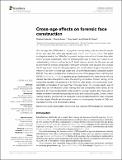Files in this item
Cross-age effects on forensic face construction
Item metadata
| dc.contributor.author | Fodarella, Cristina | |
| dc.contributor.author | Brown, Charity | |
| dc.contributor.author | Lewis, Amy | |
| dc.contributor.author | Frowd, Charlie D. | |
| dc.date.accessioned | 2017-02-10T16:30:10Z | |
| dc.date.available | 2017-02-10T16:30:10Z | |
| dc.date.issued | 2015-08-21 | |
| dc.identifier | 249063537 | |
| dc.identifier | bb9952ca-e336-4b12-8caa-09328b3e5bc5 | |
| dc.identifier | 000360022200001 | |
| dc.identifier | 000360022200001 | |
| dc.identifier | 85034984420 | |
| dc.identifier.citation | Fodarella , C , Brown , C , Lewis , A & Frowd , C D 2015 , ' Cross-age effects on forensic face construction ' , Frontiers in Psychology , vol. 6 , 1237 . https://doi.org/10.3389/fpsyg.2015.01237 | en |
| dc.identifier.issn | 1664-1078 | |
| dc.identifier.other | ORCID: /0000-0001-8616-2411/work/30305199 | |
| dc.identifier.uri | https://hdl.handle.net/10023/10269 | |
| dc.description | This work was supported in part by an award from the UK Economic and Social Research Council (RES-000-22-4150) to Dr Charity Brown and Dr Charlie Frowd | en |
| dc.description.abstract | The own-age bias (OAB) refers to recognition memory being more accurate for people of our own age than other age groups (e.g., Wright and Stroud, 2002). This paper investigated whether the OAB effect is present during construction of human faces (also known as facial composites, often for forensic/police use). In doing so, it adds to our understanding of factors influencing both facial memory across the life span as well as performance of facial composites. Participant-witnesses were grouped into younger (19-35 years) and older (51-80 years) adults, and constructed a single composite from memory of an own- or cross-age target face using the feature-based composite system PRO-fit. They also completed the shortened version of the glasgow face matching test (GFMT; Burton et al., 2010). A separate group of participants who were familiar with the relevant identities attempted to name the resulting composites. Correct naming of the composites revealed the presence of an OAB for older adults, who constructed moreidentifiable composites of own-age than cross-age faces. For younger adults, age of target face did not influence correct naming and their composites were named at the same level as those constructed by older adults for younger targets. Also, there was no reliable correlation between face perception ability and composite quality. Overall, correct naming was fairly good across the experiment, and indicated benefit for older witnesses for older targets. Results are discussed in terms of contemporary theories of OAB, and implications of the work for forensic practice. | |
| dc.format.extent | 8 | |
| dc.format.extent | 1056465 | |
| dc.language.iso | eng | |
| dc.relation.ispartof | Frontiers in Psychology | en |
| dc.subject | Own-age bias | en |
| dc.subject | Face perception | en |
| dc.subject | Facial memory | en |
| dc.subject | Facial composites | en |
| dc.subject | PRO-fit | en |
| dc.subject | Glasgow face matching test | en |
| dc.subject | BF Psychology | en |
| dc.subject | NDAS | en |
| dc.subject.lcc | BF | en |
| dc.title | Cross-age effects on forensic face construction | en |
| dc.type | Journal article | en |
| dc.contributor.institution | University of St Andrews. School of Psychology and Neuroscience | en |
| dc.identifier.doi | 10.3389/fpsyg.2015.01237 | |
| dc.description.status | Peer reviewed | en |
This item appears in the following Collection(s)
Items in the St Andrews Research Repository are protected by copyright, with all rights reserved, unless otherwise indicated.

